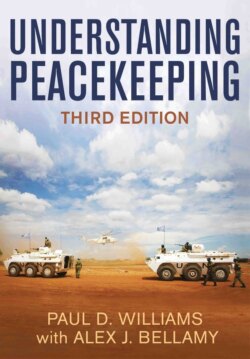Читать книгу Understanding Peacekeeping - Alex J. Bellamy - Страница 2
CONTENTS
Оглавление1 Cover
2 Title Page
3 Copyright
4 Abbreviations
5 Acknowledgements
6 Introduction Peacekeeping in global politics Enduring themes Structure of the book
7 Part I Concepts and Issues 1 Peace Operations in Global Politics 1.1 Westphalian and post-Westphalian order 1.2 Theorizing peace operations in global politics 1.3 The impacts of peace operations on armed conflict Conclusion 2 Who Deploys Peace Operations? 2.1 The universe of modern peace operations 2.2 States as peacekeepers 2.3 International organizations as peacekeepers 2.4 United Nations peace operations 2.5 Partnership peacekeeping Conclusion
8 Part II Historical Development 3 Peace Operations during the Cold War 3.1 United Nations peace operations during the Cold War 3.2 Non-UN peace operations during the Cold War Conclusion 4 Peace Operations during the 1990s 4.1 The transformation of peace operations 4.2 The nature of the transformation 4.3 Failures and retreat 4.4 Lessons learned? Conclusion 5 Peace Operations in the Twenty-First Century 5.1 Peacekeeping reborn: 1999–2002 5.2 The Brahimi Report 5.3 Peace operations after the Brahimi Report 5.4 The rise of stabilization Conclusion
9 Part III The Purposes of Peace Operations 6 Prevention 6.1 Preventing violent conflict and preventive deployments 6.2 Preventive deployments in practice 6.3 The politics of preventive deployment Conclusion 7 Observation 7.1 From observation to traditional peacekeeping 7.2 Observation in practice 7.3 Problems 8 Assistance 8.1 Assisting war-to-peace transitions 8.2 Assistance in practice 8.3 Key challenges 9 Enforcement 9.1 What is peace enforcement? 9.2 Peace enforcement in practice 9.3 Key challenges 10 Stabilization 10.1 Stabilization in theory 10.2 Stabilization in practice 10.3 Key challenges for stabilization 11 Administration 11.1 Transitional administrations in theory 11.2 Transitional administrations in practice 11.3 Key challenges
10 Part IV Contemporary Challenges 12 Force Generation 12.1 The force-generation process 12.2 Why do states provide peacekeepers? Conclusion 13 Regionalization 13.1 Regionalization and trends in peace operations 13.2 The strengths and weaknesses of regional peace operations 13.3 Regional peace operations in practice Conclusion 14 Privatization 14.1 The private security industry and peace operations 14.2 The costs and benefits of privatizing peace operations 14.3 A future of privatized peace enforcement? Conclusion 15 Use of Force 15.1 The evolution of force in peace operations 15.2 Key questions about using force in peace operations Conclusion 16 Civilian Protection 16.1 The rise and evolution of POC mandates 16.2 Consequences of POC mandates 16.3 Tensions and challenges raised by POC mandates 16.4 Assessing and reforming the UN’s POC record Conclusion 17 Gender 17.1 Peace operations and the women, peace and security (WPS) agenda 17.2 Increasing women’s participation in peace operations 17.3 Sexual exploitation and abuse in peace operations Conclusion 18 Policing 18.1 The evolution of policing in peace operations 18.2 Approaches to policing in peace operations 18.3 Challenges facing police peacekeepers Conclusion 19 Organized Crime 19.1 Organized crime and peace operations: growing convergence 19.2 Peacekeepers and organized crime 19.3 Responding to organized crime Conclusion 20 Exit 20.1 Exit in theory and practice 20.2 Political challenges 20.3 Operational challenges 20.4 Economic challenges Conclusion
11 Appendix
12 References
13 Index
14 End User License Agreement
